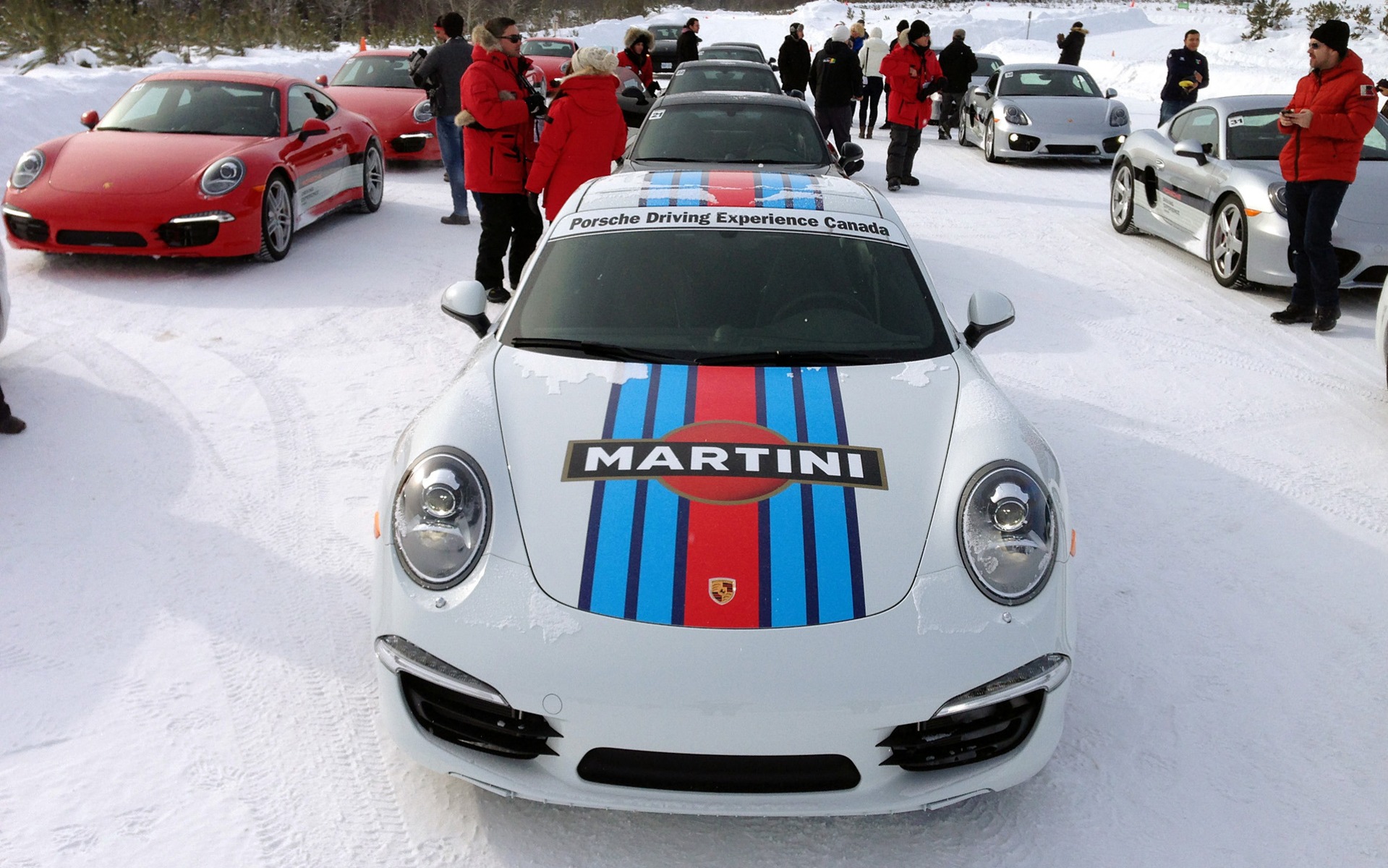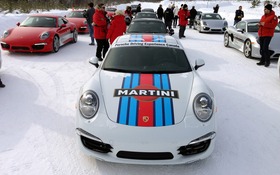Porsche Camp4: The Best Reason For A Real Winter
It was -27 degrees Celsius that morning. We were in the big parking lot of the Estérel Hotel, along the banks of Masson Lake in the Laurentians. The skin on my fingers nearly stuck to the door handle of the three-ton truck that had been parked there since the night before.
I jumped onto the frozen leather seat and turned the key; the Yukon's engine started instantly. I turned on the heated seat and steering wheel, slid the gear selector into D and was off. Destination: Mécaglisse in Notre-Dame-de-la-Merci, about another 30 kilometres north. The road was icy, so I had to take it easy, but driving gingerly put me in the right frame of mind for what was to come. Everything was perfect.
- Also: Porsche Tour Canada 150: Discovering a Country in Fast Forward
- Also: 2018 Porsche Camp4: Listen to Kees!
Porsche has set up camp at the Estérel Hotel, and will stay for almost the entire month of February. That's where the German manufacturer is putting up the team that's organizing Camp4, its winter driving program, which is in its fifth year in Canada and still run at the Kirchhoff family's superb motor sport complex. In Europe, the program has existed since 1996.
A cut above
Also staying at the Estérel were the participants who signed up for the 2015 edition of Camp4. With 354 registrations, participation has increased by about 50% compared to last year’s 240. These people were divided into six regular groups, and were joined by five other corporate groups—not a bad a team-building activity for the troops, if you ask me.
This year, a third level was added to the program. In addition to the usual Camp4 and Camp4S (run in the first part of February), there's now Camp4RS (which runs at the end of February). It’s already a tremendous success, as there are enough participants for two groups for that level compared to only one for Camp4S. The 30 available spots in each group are already taken, so better luck next year.
What are the differences between the three levels? The theme of the Camp4 program is "precision." It includes two full days of driving at Mécaglisse—always in a Porsche—in addition to three nights at the Estérel and all meals. And you eat like a king. The morning and evening meals are served at the hotel, while lunch is served in the grand chalet at Mécaglisse with soup and a hot meal provided by a caterer. Impeccable. All that for $5,195 plus taxes.
For the Camp4S program, the watchword is "performance" and the prerequisite for admission is successful completion of either Camp4 or another of Porsche's advanced driving programs. As the name suggests, the exercises are done at a faster pace and there’s another full day of driving. Of course it comes with the same accommodation and meals. For this, the price increases to $6,195.
“Performance +” is the theme of Camp4RS, which also includes three days of driving, but adds 3 mm studs (versus 1.5 mm in Camp4S) to the Nokian Hakkapeliitta tires on all the cars. Sheer ice or not, this extra grip means speeds are much higher, too.
Porsche adds more advanced exercises to the Camp4RS program. These include added challenges on the loops that Franck Kirchhoff himself mapped and cut out of the woods of his driving paradise. They’re veritable rally special stages where Canadian championship drivers come to train. The cost goes up to $7,195 and it’s already sold out. Draw your own conclusions.
A three-time participant
A media day was also added to the calendar. Essentially, it’s a condensed version of the Camp4 “precision” program. The Camp4 team welcomed about 30 bloggers and journalists from across Canada and the United States.
This was my third time taking part in this concentrated Camp4 program. I guess that all my colleagues were otherwise occupied and I was offered the opportunity again, so I saw no reason to deprive myself of such a pleasure during work hours, Arctic weather conditions or not! There’s always something new to discover and learn, even if you think you know something by rote.
The agenda for media day included various exercises executed at the wheel of a 911 Carrera S, an all-wheel drive 911 Carrera 4S or a Cayman. All vehicles were equipped with a PDK twin-clutch gearbox and tires with studs about the size of a pencil tip. There was just enough grip to take on the ice with a minimum of confidence.
The first time you hear the husky growl of a Porsche boxer at the touch of the accelerator, you get right into it. Completely. It’s physical. Resistance is futile.
Always something new
My day started with the Cayman, and my first surprise was that the loop had almost tripled in length. Both previous times I had been there I drove on a kind of rounded rectangle. Despite the changes, the conclusion is the same: it’s pure bliss to walk the tightrope on a stretch of ice in a light mid-engined vehicle with rear-wheel drive and remarkable balance and finesse.
I barely had time to think that a handful of laps weren’t enough when I had to switch to a rear-engined 911 Carrera S with 3.8-litre powerplant, 400 horsepower and rear-wheel drive. This time, the goal was to complete entire laps by constantly oversteering and counter-steering on a big, icy donut. It’s easier said than done on a surface whose grip and profile changes subtly around the circle. We went about it joyfully, lap after lap, juggling the steering wheel and accelerator like madmen.
I ended up getting it, eventually. But Pierre Des Marais, our Machiavellian instructor, gave me a grade of 99.8% because my drift angle changed ever so slightly during my best laps. This was an excellent reason to keep at it, but, alas, I had to move on to the next exercise and car.
At the next station, we had to zigzag the tail of an all-wheel drive Carrera 4S through a series of aligned cones, constantly playing with the steering wheel and accelerator. It’s harder than you’d think. A colleague gleefully scaled the thick snow surrounding the track when he miscalculated the exit of the last cone. They needed a Cayenne Diesel and a thick strap to get the 911 down.
After lunch, the fourth exercise was the most intriguing. On a longer, faster slalom course, still in a Carrera 4S, we began the curve by turning the steering wheel, then braking gently to turn the 911, straightening out the steering wheel and reaccelerating toward the next big cone. The goal was to tame the electronic central differential that transmits more torque to the front wheels if they’re turned, which only accentuates the understeer. Keeping the wheels straight is the trick to mastering big skids.
Icy crescendo
The main course, one last exercise that combines all the techniques that we rehearsed, was full laps on a long loop that joins several of Mécaglisse’s routes. For this, we drove each of the three Porsches in succession. Sixteen cars on the track at the same time. The whole fleet. First, we drove with the anti-skid activated and then we deactivated it when the head instructor saw that no cars went off the road.
And for dessert, once the cars we neatly parked in a line, we went for full-blast rides with the instructors at the wheel, still on the sheer ice. I particularly liked the long 100-metre skid near the end of a lap, the Cayman completely squared, the needle practically buried, with Pierre Des Marais shouting “yee-haw” as he brought the beast back to the chalet.
On the way home, I found myself with a case of perma-grin. I can only imagine what two or three days must be like. And then I think about the Camp4RS program with the bigger studs and Franck’s “special stages” in the middle of the woods in a Porsche. A guy can dream, can’t he?












